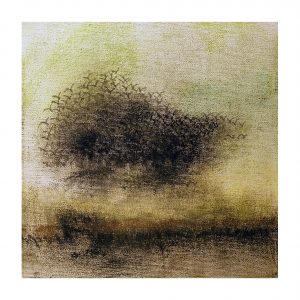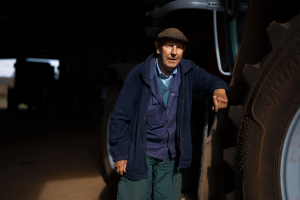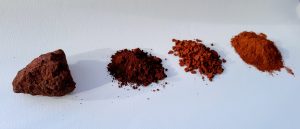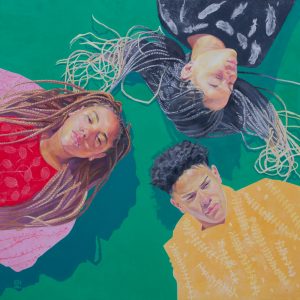Malú Colorín
Natural Dyer & Designer
Malú isn’t just changing how we dye clothes – she’s redesigning the textile ecosystem, one plant, one pigment, one workshop at a time.

From her work across Ireland to her roots in Mexico City, Malú Colorín brings together ancestral textile knowledge, ecological commitment, and creative energy in a way that feels deeply contemporary. As founder of Talú and co-founder of Fibreshed Ireland, she leads a movement that is at once tactile and transformative – offering workshops, festivals, and advocacy work rooted in land, colour, and community.
When we spoke to Malú after she had delivered an introduction to natural dyeing at Brink! in Belfast, she explained that the workshop was about getting people curious about what plants can do, what colours they can achieve, and what might already be growing around them unnoticed. For her, colour offers a playful entry point into deeper environmental awareness. “Colour can be amazing – it’s like a gateway into being interested in the natural world around you,” she explained.
One of her favourite things about teaching is witnessing the joy people experience when immersed in the process. She described the transformation that happens when adults enter what she called “a childlike state of awe” – a moment when they stop worrying about the outcome and simply enjoy creating.
That particular workshop involved dyeing kerchiefs on vintage Irish linen, repurposed from surplus donated to the Linen Biennale.
The event was also the first in a wider initiative: the Flax Meitheal, a collaborative project co-organised by Fibreshed Ireland, Talú, Brink!, Mallon Linen, the Linen Biennale, and Artpark in Germany. This series of events, taking place across Ireland and concluding with an exhibition in Germany, centres flax as both cultural heritage and ecological opportunity. “We’ll bring some of the Irish things over there,” Malú noted, speaking about the final exhibition planned by Artpark.
The Festival of Colour: An Intimate Celebration of Plant-Based Pigment
Before that, however, comes one of the most distinctive events in the natural colour calendar. Taking place this July on a farm in County Antrim, the Festival of Colour is now in its second year. It began, as so many good things do, with a conversation. During one of her online natural dyeing courses, a student mentioned that she had a farm and proposed the idea of painting tents and celebrating natural colour. Malú’s response: “Oh yeah, it would be nice. And you have a farm – let’s do it.”
Hosted at Willow and Lore, the weekend event is kept intimate, with around 50 attendees. It includes workshops, talks, and a family-friendly Sunday programme featuring forest school activities, a colour-themed treasure hunt, and hands-on learning about plants and dyes. One highlight from last year was a Brazilian illustrator painting one of the site’s bell tents using pigments made from plants – an illustration of flora created with flora.
“It’s a very intimate weekend celebration of all things natural colour,” Malú explained. A film screening, focused on a woman in the UK who grew her own pair of jeans and dyed them with plants she cultivated herself, reflects the kind of story the festival wants to champion. Children are welcome on Sunday, and guests can camp or stay in a nearby B&B reserved for the event.
Learn more or book tickets at: talu.earth/archipelago-festival-of-colour
Colour, Culture, and Responsibility
Although rooted in creativity, Malú’s work has always carried a strong ecological focus. Her concern for the environment dates back to childhood, when she dreamed of becoming a biologist to protect animals. That instinct now informs her critique of global textile supply chains and her advocacy for regional, regenerative alternatives.
Through Fibreshed Ireland, she promotes the use of fibres that grow well in local conditions. “Here in Ireland, traditionally, linen and wool would have been the main fibres – and they grow really well on this island,” she noted. Yet today, even wool from Irish sheep is often sent abroad for processing. Linen weaving still happens on the island, but the flax fibre itself is imported. Farms like Mallon Linen in County Tyrone are working to change that, but spinning infrastructure remains a challenge.
In her workshops, Malú brings in local and foraged materials like oak, hazel, alder, horse chestnut, and bramble. She also encourages people to use kitchen scraps – onion skins, avocado pits, even tea – to reveal the unexpected richness of domestic waste. For vivid results, she supplements with plants like weld and madder, as well as cochineal, a red dye derived from insects native to Mexico.
Her approach is both practical and poetic. “If you’re going to raise an animal that you’re going to eat, you should honour that animal by using all of what it has to offer,” she said, citing the Indigenous principle of respecting every part of the animal or plant. In Ireland, she sees potential in reviving that mindset: using sheep for wool as well as meat, growing flax in rotation with vegetables, and even recovering leather from the beef industry.

Generational Threads
Malú’s love for textiles is rooted in her upbringing in Mexico City. Her grandmother taught pattern cutting and sewing to elderly women in a community centre, while her mother, a dedicated quilter, taught workshops of her own. Though Malú initially thought of pursuing fashion design, she found it too glamorous, shifting instead to graphic design – a field that now informs her work in unexpected ways.
She grew up immersed in traditional clothing and still wears it proudly. “Every time I have a chance, I’ll wear traditional clothes or at least something, just because I love them so much,” she said. It’s a quiet celebration of heritage that complements her work in natural dyeing and local textiles.
A Systemic Lens
With a background in graphic design, Malú brings a systems-oriented perspective to her textile work. She sees textiles the way she once saw brand systems – where every component must work together. “Your logo, your fonts, your colours – they’re all part of one system,” she said. “So you can extrapolate that to anything.”
This mindset has helped her think critically about the textile ecosystem: how fibres are grown, processed, distributed, and valued. Through Talú, Fibreshed Ireland, and now the Festival of Colour, Malú isn’t just helping people rediscover natural dyes. She’s building a network – rooted in care, community, and colour – that invites us all to reimagine how we relate to the materials around us.
Find out about the latest events and workshops via her website: talu.earth
The Festival of Colour: Saturday 26th to Sunday 27th of July at Willow and Lore: talu.earth/archipelago-festival-of-colour
The Latest Articles

Bob Speers and the Quiet Magic of Ireland’s Bogs
In a room filled with timber, peat, and light, artworks hung on walls are more like fragments of the land itself – weathered, breathing, and alive with memory.

Hernan Farias on Light, Connection and Creative Growth
From the Classroom to the Camera – charting his shift from teaching English in Chile to full-time photography in Northern Ireland.

The Colour & Spirit of Time: Tricia Kelly’s Journey with Ócar
Exploring how sixty million years of volcanic fire, weather, and transformation created the red ochre that now colours Tricia’s life and work.

Faith and Colour: The Genuine Art of Beverley Healy
In her imaginative work, paint becomes prayer – a meditation on trust, surrender, and creation, where colour and stillness meet to form something transcendent.

Ruairi Mooney on Creativity, Practice & the Search for Authentic Art
From the North Coast to the Canvas: a journey of resilience, daily practice, and the slow discovery of an authentic artistic voice.

From Trauma Wards to Ceramics: Denise McAuley’s Authentic Creative Journey
From the trauma wards of the Royal to the shoreline of Cushendall, Denise creates small-batch ceramics that carry memory, resilience, & the rhythms of the sea.

